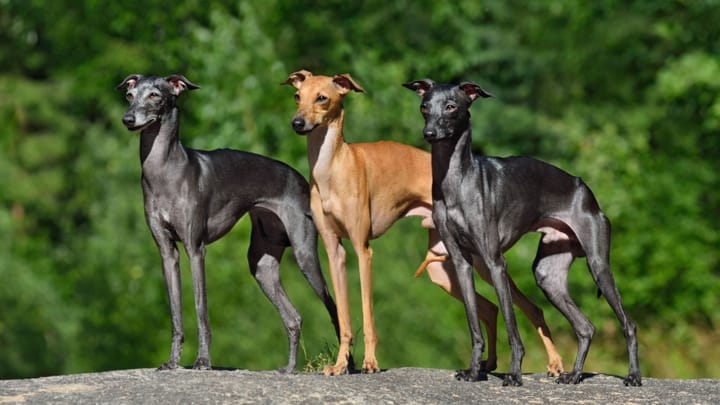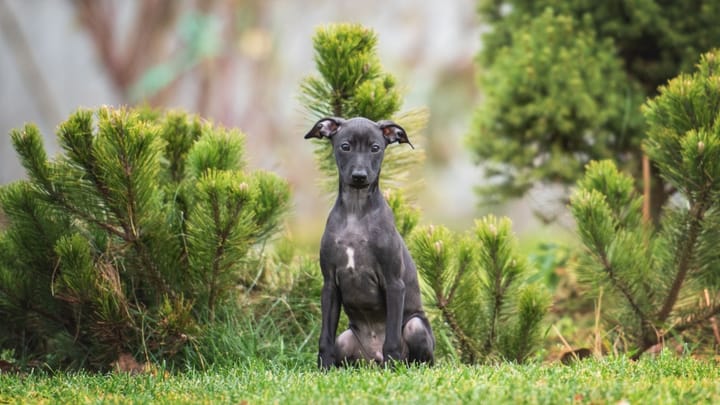Italian Sighthound
Other name: Italian Greyhound


The Italian Greyhound is a smaller, more delicate version of the standard greyhound breed. Like their larger relatives, the Italian Greyhound is well known for its soft, gentle nature and athletic abilities. They're also a very intelligent breed that responds really well to training and they love human company. The Italian Greyhound is a perfect family pet; these affectionate dogs have a natural affinity for children and form strong, lasting bonds with their owners.
|
Life expectancy |
The Italian Sighthound has a life expectancy of between 12 and 14 years |
|
Temperament |
|
|
Size |
Small
|
|
Adult size |
Female
Between 13 and 15 in
Male
Between 13 and 15 in
|
|
Adult weight |
Female
Between 7 and 11 lb
Male
Between 7 and 11 lb
|
|
Coat colour
An Italian Greyhound’s coat can be one of any 30 recognised colours, including white, brown, black, fawn, grey, and blue/grey. |
Black Blue Sand |
|
Type of coat
The Italien Sighthound's hair is very short and smooth with some shedding. |
Very short |
|
Eye colour
Eye colour varies, although it’s likely to be dark brown or a darker green. |
Brown
|
|
Purchase price |
The Italian Sighthound costs between £845 and £1230 |
Italian Greyhounds have an extremely high prey drive and will chase after pretty much anything that moves quick. This can sometimes get them into trouble, so keep them on the leash in unfamiliar areas.
Because of their slight frames, try not to walk or exercise them in rugged woodland areas. Opt for flat open parks, instead. This is really important, as Italian Greyhounds are much more accident-prone than other breeds.
Italian Greyhounds run with a double suspension gallop which is more associated with horses than dogs. Although they can’t run as fast as a standard breed, Italian Greyhounds can clock a maximum speed of up to 25mph, which is still very impressive.
More details about the Italian Sighthound
Italian Sighthound: Origins and history
The first reference to any type of greyhound appeared in ancient Egypt. Mummified remains of small, greyhound-like dogs were found in the tombs of Egyptian rulers and pictures of these same dogs appeared in the hieroglyphics that covered the walls of the pyramids. The remains of similar breeds were then discovered during archaeological excavations in Pompeii and ancient Roman sites. The more "modern" version of the Italian Greyhound breed become especially popular during the 16th and 17th centuries, when they became the dog of choice for many of the leading aristocratic European families.
Physical characteristics of the Italian Sighthound
Italian Greyhounds have slight, lean, frames with a deep chest and long thin legs. They have slender legs, long shoulders, and a narrow muzzle.
FCI classification of the Italian Sighthound
-
Group 10 - Sighthounds
-
Section 3 : Short-haired Sighthounds
Italian Sighthound: Characteristics
Italian Sighthound: Behaviour
Training a Italian Sighthound
Italian Greyhounds respond best to gentle, reward-based training methods. You’ll also need a little bit of patience as Italian Greyhounds puppies tend to be extremely boisterous, meaning they can struggle to focus on a specific task. So keep the training sessions short and fun. Around 10-15 minutes per day is ideal.
Italian Sighthound: Lifestyle
Breed compatibility Italian Sighthound
Italian Sighthound: Purchase price
A purebred Italian Greyhound pup can cost up to £1230 if they are registered at the Kennel Club, although others can be bought for around £845.
Italian Greyhounds don't need massive amounts of food, so budget between £40-60 each month to cover the cost of feeding them. Other expenses, like insurance, will vary depending on your dog's age and medical history. Overall, maintaining a healthy Italian Greyhound will cost around £900 per year.
Italian Sighthound: Shedding
Average
Shedding is moderate.
Italian Sighthound: Grooming
Italian Greyhounds have short coats which are really easy to maintain. They also shed very little, saving you the time and money involved with regular trips to the doggy salon. A quick weekly brush is all they really need.
Italian Sighthound: Health
The average lifespan for the Italian Greyhound is between 12-14 years.
Italian Greyhounds are natural born athletes with lean bodies designed for sprinting and chasing. However, they're also quite slight. Their brittle frames are nowhere near as sturdy or robust as the standard Greyhound, meaning they're more susceptible to injuries like broken bones or sprained joints. Be careful when letting them off the leash and only run them on flat, safe ground.
Italian Greyhounds have one of the shortest coats of any dog breed, meaning they tend to cope with higher temperature better than most other dogs.
A warm coat is an essential winter accessory for any Italian Greyhound. Because of their short coats and lean frames, Italian greyhounds can struggle to maintain a safe body temperature in cold weather. This means they'll always need their coats during winter and it's best to avoid walking them during the coldest parts of the day, such as early morning or late evening. You'll also do well to purchase a pita bed (a sort of sleeping bag for dogs), so that your Italian Greyhound can burrow in the warmth of his 'den' at night.
Their naturally lean frames and high-energy levels means the Italian Greyhound is highly resistant to obesity and any related health problems.
- Broken/fractured bones
- Gastric dilation volvulus (bloat)
- Epilespy
- Patellar luxation
- Periodontal disease





